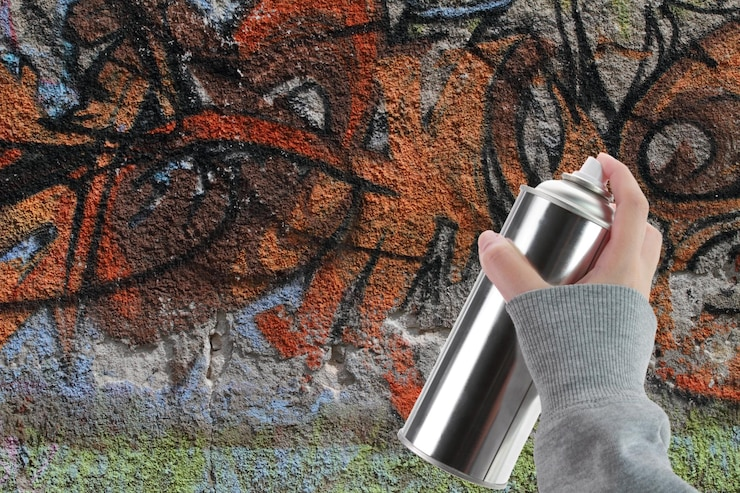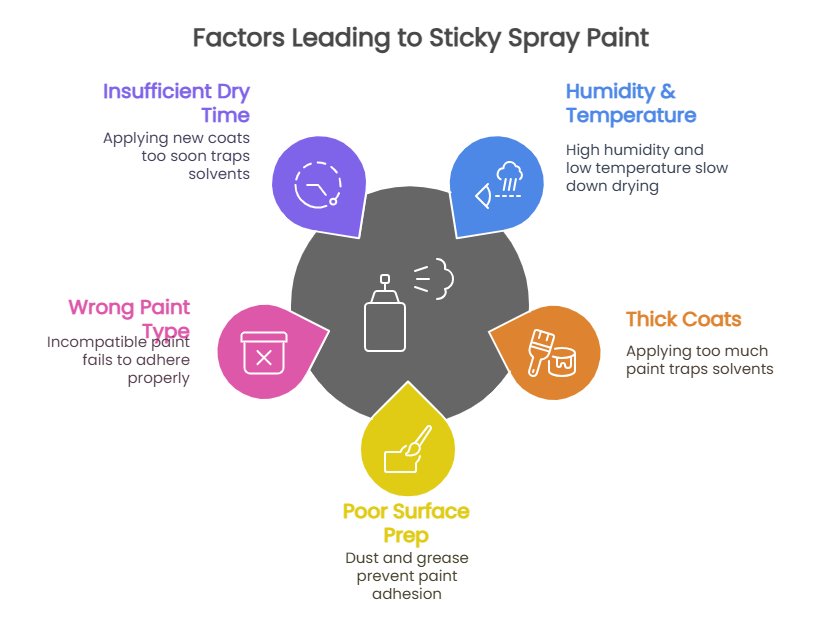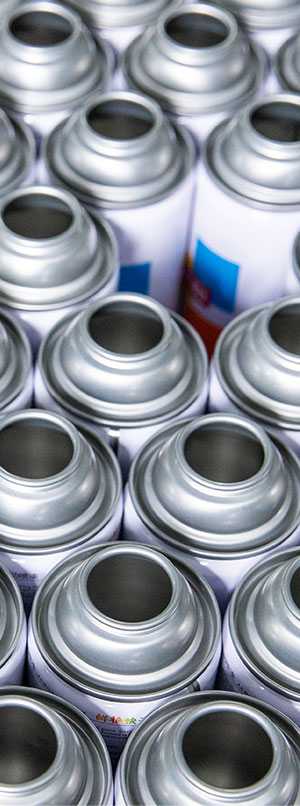Freshly sprayed, your project looked perfect. You stepped away, confident. But when you returned hours later, that sleek finish felt tacky and strange under your fingertips. That hopeful feeling deflates instantly. Discovering spray paint sticky is incredibly frustrating. It ruins the look and threatens to undo all your hard work.
Before you panic or resign yourself to starting over, know this: spray paint stays tacky is a common problem, and it’s almost always fixable. Don’t worry; we’ll pinpoint why it happened and show you exactly how to fix it and save your project!

Common Reasons Spray Paint Stays Sticky
That frustrating tackiness doesn’t just happen. Pinpointing the exact cause is your first step to fixing it. Here are the most frequent culprits:
#1: Humidity & Temperature
Painting when the air is very humid, or the temperature is too low drastically slows down the drying process. Moisture in the air interferes with the paint’s solvents evaporating properly. Think of it like trying to dry laundry in a damp basement.
#2: Thick Coats
Applying too much paint in a single layer is a surefire way to cause problems. A thick, heavy coat traps solvents underneath the surface film. These solvents struggle to escape, leaving the paint soft and sticky underneath, even if the top feels dry.
#3: Poor Surface Prep
Skipping the cleaning step is a major mistake. Dust, dirt, grease, oil, or wax left on the surface create a barrier. Paint applied over this barrier cannot form a strong bond and may remain soft or peel. Similarly, painting directly onto a very glossy surface without sanding often leads to poor adhesion and stickiness.
#4: Wrong Paint Type or Material
Not all spray paints work on all surfaces. Using a paint not formulated for your specific material, like spraying standard paint onto plastic without using a plastic primer first, often results in adhesion failure. The paint simply cannot properly grip or cure on the incompatible surface.
#5: Insufficient Dry Time Between Coats
Patience is key. If you apply a new coat of paint before the previous coat has dried enough, you trap the solvents from the first layer beneath the new layer. This prevents the solvents from fully evaporating, leading to a soft, sticky finish throughout the paint job.

How to Make Spray Paint Not Sticky
Don’t despair if your paint feels sticky. Often, you can salvage your project with the right approach. Try these solutions:
#1: Let it Cure Longer
Before taking drastic steps, give it more time. If the humidity drops or the temperature rises sufficiently, the paint may eventually harden fully on its own. Place the item in a warm, dry, well-ventilated area and wait at least 24-48 hours. Patience is sometimes the simplest fix.
#2: Use Heat or Airflow
Gentle warmth and moving air significantly speed up solvent evaporation. Position a fan to blow air across the painted surface, not directly onto it. You can also use a hairdryer set on its lowest heat setting, held at least 12 inches away. Move it constantly to avoid concentrating heat in one spot. Never use high heat or force-dry methods like heat guns, as this can blister the paint.
#3: Dust with Talcum Powder or Cornstarch
For mild, surface-level tackiness on non-decorative or hidden surfaces (like the inside of a shelf), a light dusting of talcum powder or cornstarch can absorb the stickiness. Apply sparingly with a soft cloth or brush, then wipe off any excess. Understand this is a cosmetic quick fix, not a permanent solution for visible areas.
#4: Repaint Properly
If the stickiness is severe or the other methods fail, repainting correctly is the most reliable solution. This requires:
- Sanding: Lightly sand the sticky surface with fine-grit sandpaper (220-320 grit) until it feels smooth and dull. Wipe away all sanding dust completely with a tack cloth.
- Apply thin, even coats: Repaint using very light, misting passes. Hold the can 8-12 inches away and keep it moving. Build coverage gradually.
- Allow adequate drying time: Follow the recoat times specified on the paint can exactly between each thin layer.
- Use proper primer if needed: If surface compatibility was the issue (like painting plastic), apply the correct primer first and let it dry fully before painting.

Choose SANVO For Your Project
Now that you know how to fix and prevent sticky spray paint, why not start with a high-quality product designed for flawless results? SANVO General Purpose Spray Paint is a thermoplastic acrylic aerosol spray that delivers easy application, fast drying, and a durable, professional finish.
Key Features Included:
- Fast-drying: Reduces sticky paint risks
- High solid content: Rich, durable coverage
- Smooth atomization: Even application
- Multi-surface use: Metals, wood, glass, ABS
- Weather-resistant: Long-lasting protection
- 3-year shelf life: Stays fresh for future projects
Contact us now to upgrade your spray paint game! Your projects deserve the best!
